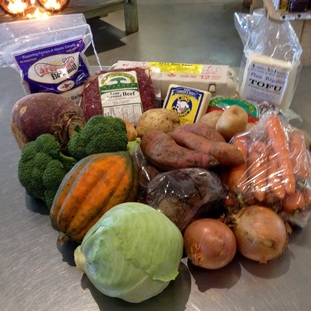It is challenging to write an article on the cost of eating locally when there are so many more costs to consider other than just what comes out of our wallets. However, I understand that the actual cost of food can create barriers to creating a healthy diet. Other barriers to eating healthy include a self perceived lack of ability to cook, time management, small kitchen space or storage space, etc.
Although dependent on the time of the year, method of production (organic or conventional), food preferences, food items and the store, with the right resources, seasonal foods can decrease your grocery bill. When it comes to fruits and vegetables, locally sourced produce is generally on par with or below imported prices. When local food is readily available such as apples, carrots, squash and potatoes in the fall, for example, they are generally less expensive when purchased locally than when imported. Even spinach, mixed greens and arugula can be less expensive than imported greens during peak season. Some exceptions may include imported berries, unless purchased at peak season or at U-Picks. Furthermore, it can sometimes prove difficult for local farmers to compete with imported goods, especially when larger scale grocery stores have sales and promotions.
As for protein sources, meat products from local suppliers who raise their animals more humanely than large scale farms are generally on par with or a bit more expensive than meat from animals raised on large scale, commercial farms. The biggest difference you’d see would be in poultry as there can be a big gap in the per pound price. I will note that “organic” eggs in the grocery store or “free run/range” eggs are comparable to the price at the farmer’s market or Local Source.
When comparing vegetarian protein sources, however, the prices are the same across the board, or similar enough. In saying that, a diet that includes local, seasonal foods could include vegetarian protein sources once in a while in order to decrease the total cost of protein. In fact, those on a seasonal diet can often rely heavily on legumes such as beans, lentils and dried peas, all of which are inexpensive. When it comes to using legumes, knowing how to use and cook them properly is necessary in order to be comfortable with replacing animal protein for vegetarian protein.
Finally, it may appear to be less expensive to buy ready-made pizzas, lasagnas, casseroles, etc., but I assure you in buying the ingredients to make all of these meals, not only will you save money per serving, you will have leftover groceries for preparing more meals. It is also far healthier to make a large dish of food for a couple of days than to buy a ready made dish which is often high in sodium and includes ingredients which do not provide our bodies with nourishment.
If you want to learn more about food preparation skills, time management skills, seasonal diets or are looking for cooking resources and recipes, contact me at nicole.marchand@eatwellhalifax.ca or book an appointment with me using the booking tab on my website.

Cost of groceries from Local Source Market: $44.62
This grocery order includes grains and starchy vegetables, various animal and vegetarian protein sources, dairy and seasonal vegetables.
One can make 20+ servings of full meals with this grocery order.
Cost of groceries from Local Source Market: $32.50
This grocery order includes grains and starchy vegetables, vegan protein sources and seasonal vegetables. One can make about
15 servings of full meals with this grocery order.

